
Maybe this is your first time dealing with a smart remote, or maybe you’re already tinkering with the Ecobee thermostat itself. Either way, you expect the whole thing just to work—set it and forget it, right? Instead, you’re reading about random reboots, error messages, and “lost connection” notifications. If you’ve ever found yourself waving the remote around, hoping it will just behave, you’re not alone.
The Ecobee SmartSensor remote is a small wireless device, usually about the size of a domino. It keeps track of temperature or motion in rooms far from the wall thermostat. Clever idea—when it’s working. But when you find yourself hunting for answers on “Why does my Ecobee smart remote keep rebooting?” the cleverness quickly loses its shine. Let’s break down why this might happen and how to fix it, one easy step at a time.
Understanding How the Ecobee Smart Remote Works
Here’s the thing: the Ecobee SmartSensor remote isn’t just a basic clicker. It’s more like a little brain scattered around your house, gathering info about temperature and movement. It sends this data wirelessly to your main Ecobee thermostat, which then adjusts your heating or cooling to keep everything comfortable and energy-efficient. When everything’s in sync, you hardly notice it. But when the remote keeps rebooting, it’s like a group project where one member keeps logging off Zoom—nobody gets the full picture.
Each time the remote restarts, it has to reconnect, resync, and sometimes even pair again with the thermostat. That means interruption in comfort, lost data, or extra work for the system to keep up. So, if your rooms start feeling colder or warmer than they should, or your thermostat seems confused, the culprit could be a glitchy sensor.
SmartSensor remotes rely on a small battery for power and a clear wireless signal to communicate. Any problems with these—not enough juice, weak signal, or software bugs—can send the remote into a reboot loop. Think of it like a kid’s walkie-talkie: if the batteries are dying or you’re too far from your friend, you’re just going to keep getting static. Ecobee designed these to be simple, but even the smartest gadgets need a little troubleshooting now and then.
Common Causes of Ecobee Smart Remote Rebooting
Honestly, most reboot problems boil down to a handful of suspects. The sensor is either struggling to stay powered up, can’t talk to the thermostat, or is running buggy code. Here’s what tends to go wrong:
- Low battery: The SmartSensor runs on a coin cell battery. When it drops below a certain charge, the device can’t hold its connection and will constantly try to restart.
- Signal interference: Anything from thick walls, metal furniture, or even your neighbor’s Wi-Fi can scramble the remote’s wireless code. If the signal drops, the sensor may repeatedly reboot to try and reconnect.
- Software glitches: Outdated firmware or a bad update can freeze the sensor in a reboot loop. Updates are supposed to sync automatically, but sometimes they get stuck, just like any other smart device.
- Pairing and sync problems: If the remote can’t solidly pair with the Ecobee thermostat, it gets stuck in a cycle of trying, failing, and rebooting in hopes of making the connection.
If you’ve ever noticed the SmartSensor’s LED blinking or flashing unexpectedly, that’s its version of saying, “Hey, something’s up over here!” It might attempt to reset itself, hoping a fresh start will solve the problem—sometimes it works, sometimes it doesn’t.
Signs Your Ecobee Smart Remote Is Rebooting
You might be wondering, “How can I actually tell if my Ecobee remote is rebooting and not just sleeping or disconnected?” Here are some telltale signs:
- Frequent blinking: The sensor’s LED flashes or blinks at odd intervals, even when it should be idle.
- Repeated ‘lost connection’ notifications: Your Ecobee thermostat app keeps letting you know the sensor’s offline, only to say minutes later that it’s back online.
- Room temperature suddenly missing: The room where the sensor lives stops reporting data, or the readings jump around like a rollercoaster.
I’ve seen people try moving the sensor, changing rooms, or even putting it in the fridge (don’t do this, by the way) just to “wake it up.” Sometimes that works, but if reboots keep happening, it’s a sign of something deeper. Don’t ignore it—those little bugs can add up to bigger comfort or energy problems in the long run.
Troubleshooting Ecobee Smart Remote Rebooting: Step by Step
Let me explain how to walk through the most common fixes—think of this as the “smart remote first-aid kit.” Here’s how to get your Ecobee SmartSensor back on track:
1. Replace the battery: Even if the battery isn’t fully dead, it might not hold enough charge for stable operation. Pop out the old coin cell (usually a CR2477), then insert a fresh one. Make sure the positive side faces up. Let the sensor sit for a minute before trying to pair it again.
2. Check the location: If your sensor lives behind thick walls or near a microwave (yep, really), the signal can struggle. Try moving it into the same room as the thermostat, at least while testing. If reboots stop, move it a little farther each time until you find a good spot.
3. Reset and re-pair the sensor: Sometimes, the pairing code gets scrambled. Remove the sensor from your Ecobee app, then hold down its button (if it has one) for about 10 seconds to force a manual reset. Add it back to the app, wait for it to sync, and see if the issue disappears.
4. Double-check for software updates: Open the Ecobee app and see if any firmware updates are pending for your devices. Out-of-date software can cause all sorts of weird problems. Update everything, then reboot the main thermostat and sensors.
If after all this you still see the sensor rebooting, it might be a hardware issue or a rare bug. At that point, reaching out to Ecobee support makes sense—they’re actually pretty friendly, in my experience.
How Battery Issues Cause Remote Reboots
Batteries are like the unsung heroes of every gadget—and the biggest troublemakers when they start to fail. Ecobee SmartSensor remotes use small, round coin cell batteries. They’re easy to forget about until problems start popping up.
Here’s the thing: if the battery can’t supply consistent voltage, the sensor will try to protect itself by rebooting. It’s like how a smartphone shuts off when the battery is almost empty, even if it shows a little bit of charge left. The sensor’s tiny chip needs steady power to keep its code running, and even a half-dead battery can make it loop endlessly between “on” and “off.”
But don’t go buying a carton of batteries just yet. Before swapping them out, check the battery type in your remote. Sometimes, people use the wrong size or brand, which can lead to poor contact or weak performance. Always use the recommended CR2477 type, and if you grab a generic brand, be prepared to replace them more often.
If you’re still seeing reboots after popping in a fresh battery, move on to the next troubleshooting steps. But trust me—battery issues are the
Impact of Wireless Connection and Interference
Wireless signals are everywhere—Wi-Fi networks, Bluetooth speakers, smart doorbells. Each device is like a person yelling in a crowded room, hoping to be heard by someone across the way. Your Ecobee smart remote is shouting at the thermostat, hoping it’s close enough and not drowned out by all the noise.
Thick walls, metal appliances, mirrors, and even fish tanks can block or bounce signals. Other wireless gadgets, old microwaves, or crowded Wi-Fi channels can also interfere. If your sensor keeps rebooting, it might be losing its connection and hitting reset, hoping for a clearer shot.
Try moving the sensor closer to your thermostat, even if just for a test. If the reboots stop, you know interference is likely. Rearranging the sensor’s location or moving large metal objects can sometimes fix things. If your house is big or unusually solid (think lots of brick or concrete), you might need to accept that some rooms are just out of reach—or get creative with placement.
Software Updates, Resetting, and Firmware Glitches
Like all smart devices, Ecobee’s remotes and thermostats run little bits of code—firmware—that tell them how to behave. These are usually set-and-forget, but when something goes wrong (stuck updates, old firmware), the smart remote might get confused and keep rebooting.
If you suspect a code problem, force a reset. Remove the sensor from your Ecobee app, then do a hard reset on the remote itself. After the reset, re-pair it with the thermostat. Watch for any prompts to update firmware in the Ecobee app and follow through immediately.
If a new software patch caused the issue—maybe after a recent automatic update—check online forums or contact Ecobee’s support. Sometimes, it’s a known problem waiting on a fix, and they can walk you through a workaround.
Don’t forget to reboot the main thermostat, too, just to be thorough. Sometimes, the whole system needs a “fresh start” to get its sensors and code talking again.
Comparing Ecobee Smart Remote to Universal Remotes
Maybe you’re starting to wonder if switching to a universal remote is a good idea. Here’s why the Ecobee SmartSensor stands out—and why its quirks can be so frustrating.
Universal remotes are often “one-size-fits-all.” They work for many different devices but miss out on deep integration. The Ecobee SmartSensor only talks to the Ecobee system, but it sends exact room data—temperature, motion, and presence—straight to your thermostat in real time. That means more accurate comfort and better energy savings.
The flip side? When a universal remote fails, it usually just stops responding. With the SmartSensor, rebooting can cause random ups and downs in comfort, unpredictable HVAC behavior, and lost data. Honestly, the trade-off is worth it if you really want that “smart home” feeling, but you’ve got to be willing to tinker a bit when things don’t go as planned.
If you need a backup, universal remotes are a stopgap, but they won’t give you the same features or data. If you’re invested in Ecobee for the smart home experience, sorting out those reboots is usually the smarter play.
When to Contact Ecobee Support
Here’s a little reality check: sometimes, you do everything right—change the battery, reset the sensor, update the software—and the smart remote *still* keeps rebooting. It happens. Electronics aren’t perfect; sometimes things break or arrive with defects.
If you’ve worked through all the troubleshooting steps and the sensor acts up no matter what, reach out to Ecobee support. Have your remote’s serial number handy, and keep track of what you’ve already tried. Support teams love that. They can check if your model has a rare hardware bug or is still under warranty.
Insight: Replacing a single sensor is usually quick and painless if you’re under warranty, and Ecobee’s team can sometimes push out a software fix remotely.
It might feel like a hassle, but getting professional help is sometimes the fastest path back to smooth, automatic comfort.
Wrapping Up: Making Your Ecobee Smart Remote Reliable Again
All things considered, a rebooting Ecobee SmartSensor remote can be a real headache—but it’s usually something you can fix at home. Whether it’s a tired battery, a stubborn wireless connection, or a little code confusion, most issues are basic and solvable. Take a breath, follow each troubleshooting step slowly, and don’t be shy about reaching out for help if you hit a wall. Once you’ve got it running smoothly, you’ll be back to that futuristic, hassle-free smart home vibe in no time—and probably with a better sense of how the whole system fits together.
